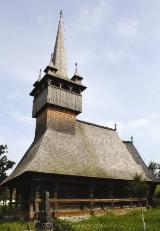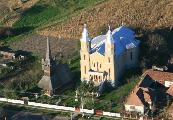 The church is one of the most beautiful wooden ecclesiastic monuments of Satu Mare County. The first church of Corund was mentioned in a law-suit, in 1494. The present church, built in 1723, is similar to other churches of the Codru area, built during this period. The region is rich in forests, therefore it offered the community plenty of wood as source of building materials. The church was first built in the center of the cemetery, on top of a hill, and then it was moved in the center of the village, in 1868. The transport took two years, and was made on wooden plates pulled by oxen. The mass was celebrated whenever Sunday came during its transportation. Even today, the building can be observed from a far, due to its high tower, built above the pronaos. The tower, a common feature of the churches of Codru region, has large ground-level, and a protruding gallery. The steeple of the tower is
The church is one of the most beautiful wooden ecclesiastic monuments of Satu Mare County. The first church of Corund was mentioned in a law-suit, in 1494. The present church, built in 1723, is similar to other churches of the Codru area, built during this period. The region is rich in forests, therefore it offered the community plenty of wood as source of building materials. The church was first built in the center of the cemetery, on top of a hill, and then it was moved in the center of the village, in 1868. The transport took two years, and was made on wooden plates pulled by oxen. The mass was celebrated whenever Sunday came during its transportation. Even today, the building can be observed from a far, due to its high tower, built above the pronaos. The tower, a common feature of the churches of Codru region, has large ground-level, and a protruding gallery. The steeple of the tower is an octagonal pyramid and it has at the basis four small towers. This type of church with a single nave and eastern sanctuary with five sides is common in Transylvania, Moldova and Walachia, and it was inherited over ages. The walls are decorated on the outside with a sculpted, very prominent, rope-shaped belt. The same ornament is at the door frame. Inside, the mural painting is the most remarkable, dating from the 19th century. In the pronaos, on the western wall the theme of the Last Judgement is depicted. The popular beliefs of the world beyond and on the punishment of the sinners are frequent themes of the church paintings of Codru Region. The main motive is the “work of Hell” dominated by demonic figures. The main character, Lucifer, blames the soul for all sin made during the life: lie, calumny, laziness, greed, drunkenness, theft, jealousy, pride, anger, crime, filthiness, adultery, sodomy, heresy, unfaithfulness, and mercilessness. Every iconographic register is accompanied by the proper text for the depicted scene: “money that overcame the law”, “women who aborts a child”, “the greed who takes someone else’s land”, “who is cursing his parents”, “who is playing dirty”, “the laziness”, “the theft” etc. The iconography of the frescoes in the nave is in accordance with the Byzantine tradition. On the images the innovations, made at the end of the 18th century by the church painters of Transylvania are observable. The church emanates noblesse and refinement, being a true witness of the values of the traditional Romanian architecture. The edifice is enlisted as national monument. (DB).
an octagonal pyramid and it has at the basis four small towers. This type of church with a single nave and eastern sanctuary with five sides is common in Transylvania, Moldova and Walachia, and it was inherited over ages. The walls are decorated on the outside with a sculpted, very prominent, rope-shaped belt. The same ornament is at the door frame. Inside, the mural painting is the most remarkable, dating from the 19th century. In the pronaos, on the western wall the theme of the Last Judgement is depicted. The popular beliefs of the world beyond and on the punishment of the sinners are frequent themes of the church paintings of Codru Region. The main motive is the “work of Hell” dominated by demonic figures. The main character, Lucifer, blames the soul for all sin made during the life: lie, calumny, laziness, greed, drunkenness, theft, jealousy, pride, anger, crime, filthiness, adultery, sodomy, heresy, unfaithfulness, and mercilessness. Every iconographic register is accompanied by the proper text for the depicted scene: “money that overcame the law”, “women who aborts a child”, “the greed who takes someone else’s land”, “who is cursing his parents”, “who is playing dirty”, “the laziness”, “the theft” etc. The iconography of the frescoes in the nave is in accordance with the Byzantine tradition. On the images the innovations, made at the end of the 18th century by the church painters of Transylvania are observable. The church emanates noblesse and refinement, being a true witness of the values of the traditional Romanian architecture. The edifice is enlisted as national monument. (DB).References:
Bărnuţiu, Elena – Kiss, Imola, „Pictura murală a bisericii din Corund între tradiţia post-bizantină şi influenţa barocului occidental”, în Relaţii interetnice în zona de contact româno-maghiaro-ucraineană din secolul al XVIII-lea până în prezent, Satu Mare, 1999, p. 580–590.
